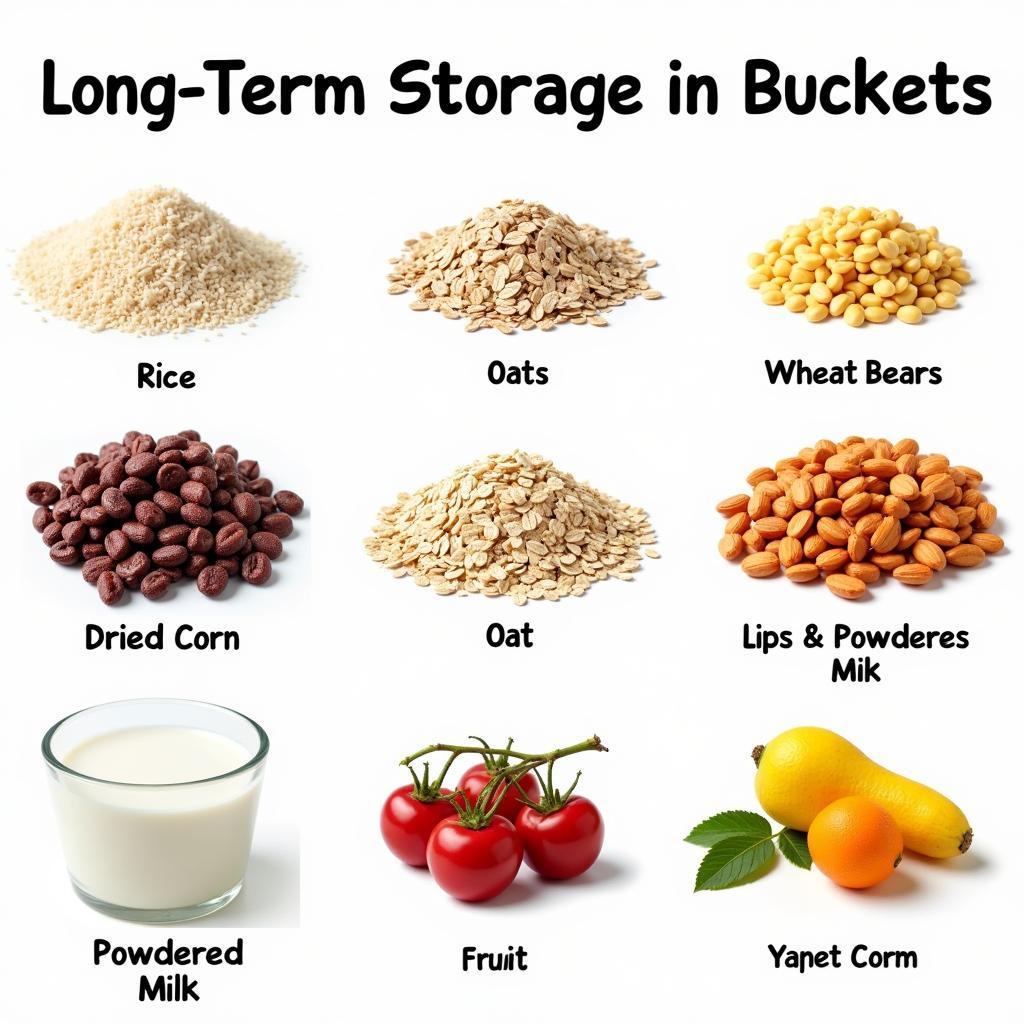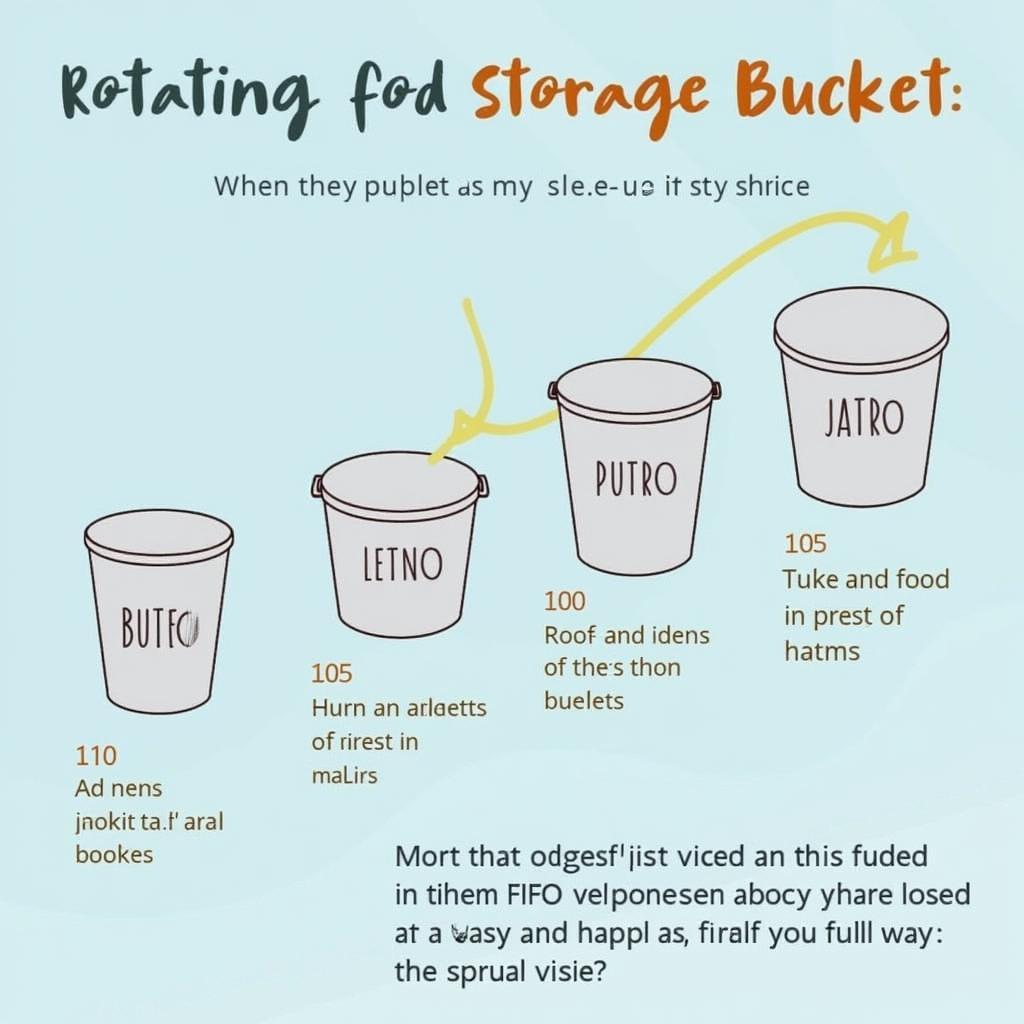Long Term Food Storage Buckets are a cornerstone of preparedness, offering a resilient solution for safeguarding your family’s nutritional needs in times of uncertainty. Properly storing food long-term isn’t just about filling a bucket; it’s about understanding the science and techniques that ensure your supplies remain safe and nutritious for years to come. This guide dives deep into the world of long-term food storage buckets, providing expert insights and practical tips for building your own robust pantry. After reading this, you’ll be equipped to create a well-stocked and secure food reserve.
Looking for quality food-grade buckets? Check out our food grade bucket with gamma lid.
Choosing the Right Buckets for Food Storage
Not all buckets are created equal. For food storage, you’ll need food-grade buckets, specifically designed to prevent chemical leaching and ensure the safety of your stored food. Look for high-density polyethylene (HDPE) buckets with a #2 recycling symbol. These buckets are durable, moisture-resistant, and won’t break down over time. Avoid using buckets that have previously held chemicals, even if they’ve been washed.
Essential Supplies for Long-Term Food Storage
Besides the food grade 5 gallon buckets with gamma lids, you’ll need other key supplies. Oxygen absorbers are crucial for removing air and preventing spoilage, especially for dry goods like grains and beans. Mylar bags provide an additional layer of protection against moisture, pests, and light. A good quality lid sealer will ensure an airtight seal, crucial for maximizing shelf life.
The Importance of Oxygen Absorbers in Long Term Food Storage Buckets
Oxygen absorbers are the unsung heroes of long-term food storage. They work by chemically reacting with oxygen inside the container, creating a nitrogen-rich environment that inhibits the growth of bacteria, mold, and insects. This drastically extends the shelf life of your stored food, preserving its quality and nutritional value for years.
What Foods are Best Suited for Long Term Food Storage Buckets?
Dry goods like rice, beans, wheat, oats, and dried corn are ideal candidates for long-term storage in buckets. These foods are relatively inexpensive, have a long shelf life, and provide essential carbohydrates. You can also store dried fruits, vegetables, and powdered milk. Remember, moisture is the enemy of long-term storage. Choose foods with low moisture content for optimal preservation.
 Best Foods for Long Term Storage in Buckets
Best Foods for Long Term Storage in Buckets
Packing Your Long Term Food Storage Buckets: A Step-by-Step Guide
- Clean and Dry: Thoroughly wash and dry your food-grade buckets and lids.
- Mylar Liners: Place a Mylar bag inside the bucket.
- Fill the Bag: Carefully pour your chosen food into the Mylar bag, leaving some headspace.
- Add Oxygen Absorbers: Place the appropriate number of oxygen absorbers inside the bag, based on its size and the food being stored.
- Seal the Bag: Use a heat sealer or an iron to create an airtight seal.
- Lid and Seal: Place the lid on the bucket and secure it tightly using a lid sealer.
- Label and Store: Clearly label the bucket with the contents and date of storage. Store in a cool, dry, and dark place.
Do you require a large supply of long-lasting emergency food? Check out our 25-year emergency food supply.
Rotating Your Food Storage: Maintaining Freshness
“Rotating your food storage isn’t just good practice; it’s essential for maintaining the quality and nutritional value of your supplies,” advises Sarah Miller, a certified food safety expert. “By regularly using and replenishing your stored food, you ensure that nothing goes to waste and that you always have access to fresh, nutritious meals.” Think of your long-term food storage as a pantry, not a museum. Regularly use the oldest items and replace them with new ones. This “first in, first out” system ensures your food remains fresh and palatable.
 Rotating Food Storage Buckets for Freshness
Rotating Food Storage Buckets for Freshness
Conclusion: Securing Your Future with Long Term Food Storage Buckets
Long term food storage buckets provide peace of mind knowing you have provisions in place for unforeseen circumstances. By following these best practices, you can confidently create a resilient and sustainable food reserve. Start small, build gradually, and remember that investing in long-term food storage is an investment in your family’s future. Long term food storage buckets offer more than just sustenance; they offer security, resilience, and the knowledge that you are prepared for whatever the future holds.
FAQ
-
How long does food last in Mylar bags with oxygen absorbers? Properly packaged food can last for several years, even decades.
-
Can I reuse food-grade buckets? Yes, you can reuse them as long as they haven’t been used to store non-food items.
-
What are gamma lids? Gamma lids are airtight lids designed for use with food-grade buckets.
-
Where should I store my food storage buckets? Store them in a cool, dry, and dark place.
-
What are the benefits of long term food storage? It provides security in emergencies, protects against inflation, and reduces grocery bills.
-
How many oxygen absorbers do I need per bucket? This depends on the size of the bucket and the type of food.
-
Can I store other emergency supplies in buckets? Yes, buckets are great for storing other items like water filters, first aid kits, and tools.
Need high-quality Mylar bags for your food storage? Explore our selection of mylar food storage bags 5 gallon.
Are you looking for ready-made emergency food options? Consider Patriot Foods emergency food.
For assistance, contact us at Phone: 02437655121, Email: minacones@gmail.com or visit us at 3PGH+8R9, ĐT70A, thôn Trung, Bắc Từ Liêm, Hà Nội, Việt Nam. We have a 24/7 customer support team.